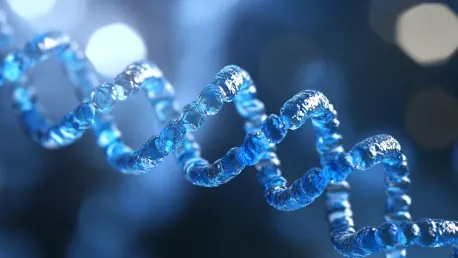Huntington’s disease (HD), a devastating inherited neurodegenerative disorder, typically manifests in adulthood, progressively impairing motor functions, cognitive capabilities, and overall brain function over approximately 15 to 20 years post-diagnosis. Despite the discovery over three decades ago that HD is caused by a “genetic stutter” mutation involving the repetition of the DNA sequence CAG in the huntingtin gene, the exact mechanisms by which this mutation translates to the disease’s devastating symptoms have remained elusive. This prompts ongoing research in genetics and molecular biology to uncover the intricate processes driving HD, particularly focusing on mismatch DNA repair genes, which have shown potential in offering new therapeutic avenues.
The Genetic Basis of Huntington’s Disease
The UCLA study delves into the genetic intricacies underpinning Huntington’s disease, concentrating on mismatched DNA repair genes. These genes orchestrate neuron damage in brain regions critically affected by the disorder, offering a new understanding of the neuropathological processes in HD. Huntington’s disease selectively targets specific types of neurons in restricted brain areas despite the mutated protein’s presence throughout the entire body. This selective vulnerability phenomenon, while prominently seen in HD, is not exclusive to it. Similar patterns of selectivity are observed in various neurodegenerative diseases such as Alzheimer’s, Parkinson’s, and Amyotrophic Lateral Sclerosis (ALS), each affecting distinct neuron types.
Recognizing the importance of neuron selectivity provides a crucial insight into potential therapeutic strategies. By understanding why certain neurons are more vulnerable than others, targeted therapies can be developed to protect these neuron types. This could be particularly beneficial in delaying the onset of symptoms and slowing the progression of HD. The study by UCLA thus explores these genetic mechanisms with the hope of unlocking new pathways to treat or even prevent this debilitating condition.
The Role of Modifier Genes
Significant breakthroughs emerged from a recent human genetic study that identified roughly a dozen genome regions containing DNA variants acting as “modifiers” of HD, either hastening or delaying disease onset by several years. Notably, many of these regions house genes responsible for DNA mismatch repair. This discovery was pivotal, as it highlighted the critical role of mismatch repair genes in HD progression. The UCLA study identifies a particular subset of these genes as drivers in the disease, affecting specific neuron types.
Dr. X. William Yang and his team at UCLA’s Department of Psychiatry and Biobehavioral Sciences, along with the Semel Institute, utilized HD model mice bearing 140 CAG repeats (referred to as the Q140 model) to replicate HD features in mice accurately. Their objective was to determine if manipulating nine HD patient-derived modifier genes, including six mismatch repair genes, could influence disease characteristics and outcomes. Such experimental approaches not only affirmed the role of these genes as modifiers but also provided a clearer understanding of how they contribute to HD’s selective neuronal vulnerability.
Experimental Findings in HD Model Mice
In their experiments, the HD mouse models displayed numerous HD-like traits concentrated in neurons vulnerable to the disease. These mice, despite their lack of overt neuron death due to shorter lifespans, revealed multiple pathological hallmarks similar to those in HD patient brains. These included abnormal gene expression in striatal neurons and the accumulation of mutant Huntingtin protein aggregates. These protein aggregates, initiating in striatal neurons and subsequently appearing in cortical neurons, deteriorate progressively over time, mirroring human HD progression.
The study’s findings were remarkable; HD mice without certain mismatch repair genes, notably Ms### and Pms1, showed significant corrections in gene expression deficits and a reduction in Huntingtin aggregates across the brain. Moreover, the absence of these genes ameliorated hallmarks of pathology, hinting at the deep impact these mismatch repair genes have on the disease’s progression. This experimental insight underscores the potential of targeting specific gene modifications to influence the course of Huntington’s disease.
Therapeutic Implications of Targeting Mismatch Repair Genes
Targeting mismatch repair genes, particularly Ms###, showed significant therapeutic potential. Inhibition of Ms### ameliorated movement and gait problems, improved synaptic protein levels in neurons, and reduced glial cell over-activity. These benefits remained persistent up to 20 months in mice, suggesting profound and sustained impacts of inhibiting mismatch repair genes in HD management. This extended improvement supports the notion that such interventions have long-term benefits, offering hope for more effective treatments in humans.
The study posits that in HD, mutant huntingtin CAG repeats are unstable within adult brain cells, especially in neurons like striatal medium spiny neurons (MSNs). This instability links to further gene expression changes and potential neuronal death, marking these neurons as primary targets for therapeutic intervention. The ability to stabilize these repeats by manipulating mismatch repair genes offers a potential pathway to slow disease progression and enhance the quality of life for HD patients.
Mechanistic Insights and Potential Therapies
The UCLA team demonstrated that stopping a subset of CAG repeats from expanding, particularly through deleting copies of Ms###, significantly reduced the repeat expansion rates in the most susceptible MSNs. This remarkable result consolidates the role of mismatch repair genes in driving HD pathology within vulnerable neurons by promoting rapid CAG repeat expansion. Such mechanistic insights forge a direct link between modifier genes identified in HD patients and the selective neuronal vulnerability observed.
Out of the six evaluated mismatch repair genes, four—Ms###, Pms1, Ms##, and Ml#—were found to strongly or moderately influence HD pathogenesis. These genes encode a minor mismatch repair complex conserved across organisms, highlighting their importance within the broader genetic framework. Importantly, some of these genes, such as Ms### and Pms1, are not associated with cancer, making them relatively safer targets for therapeutic development. This distinction provides a strategic advantage in drug development, as targeting non-cancerous pathways reduces potential adverse effects.
Broader Implications for Neurodegenerative Disorders
Targeting mismatch repair genes could benefit several brain regions impacted by HD, such as the striatum and cortex. This highlights the potential for therapies not only to delay disease onset but also to slow its progression. The HD mouse model, with its distinct molecular, pathological, and behavioral traits, offers a valuable platform for testing novel treatments aimed at HD modifier genes or enhancing the resilience of HD-affected neurons. This model’s accuracy in mimicking human HD traits makes it a critical tool for ongoing research.
Furthermore, the implications of this research extend to over 30 other neurological disorders caused by inherited dynamic DNA repeat mutations. These disorders often involve similar mechanisms of mismatch repair genes affecting repeat instability or disease severity. Thus, the findings and approaches developed in this study could pave the way for therapies addressing multiple neurological conditions, from those affecting youth to those manifesting later in life. By understanding and manipulating these genetic pathways, researchers can potentially create broad-spectrum therapies applicable to various neurodegenerative disorders.
Collaborative Efforts and Future Directions
Ongoing research in the fields of genetics and molecular biology aims to uncover these mechanisms. Scientists are particularly interested in understanding the role of mismatch DNA repair genes in the development and progression of HD. These genes, which are responsible for correcting errors that occur during DNA replication, have shown promise in opening new avenues for therapeutic approaches. By delving deeper into these genetic repair processes, researchers hope to develop strategies that might delay the onset or progression of HD, ultimately improving the quality of life for those affected by the disease.









